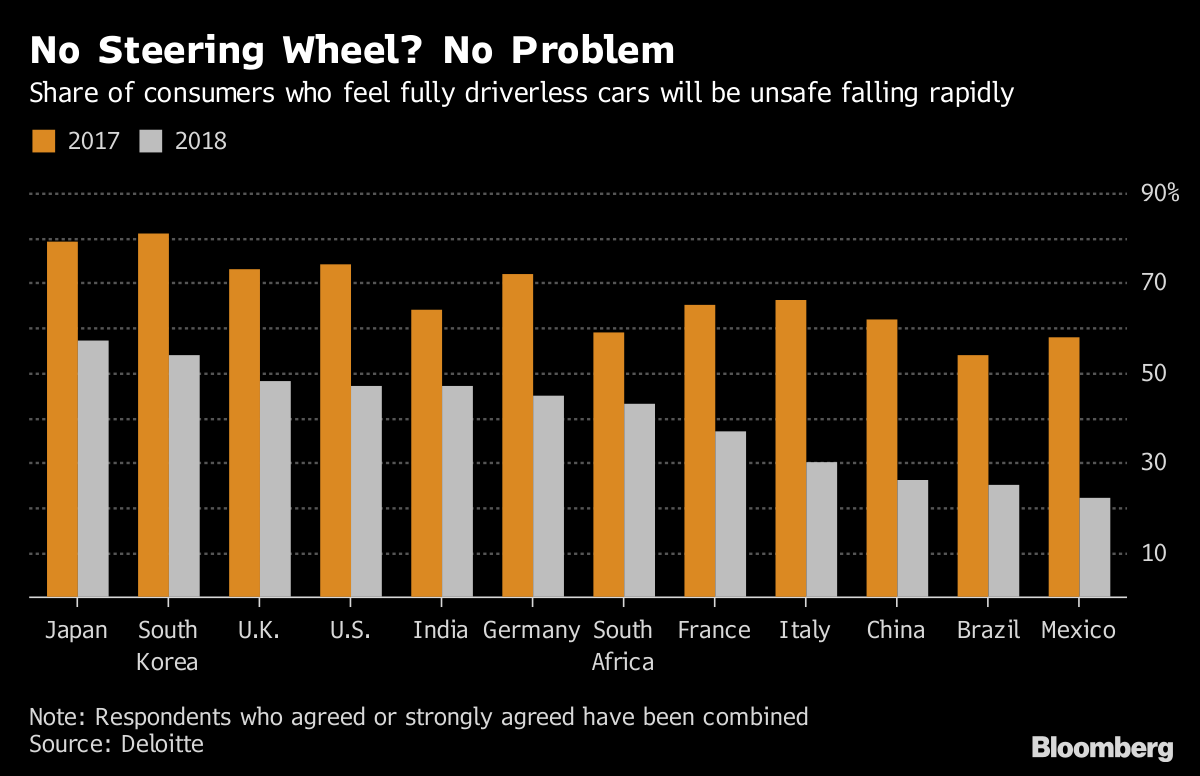It had snowed, rained and even hailed a little that morning in the northern French region of Normandy, and we were about to take a new car out for a test drive — a unique model Renault SA built and polished for over two years.
Our stress levels were at a peak when the time came to push two buttons near the middle of the steering wheel, watch it retract, and feel the car take over and switch lanes at 80 miles per hour on a public highway.
In a landscape of experiments led by Alphabet Inc.’s Waymo and General Motors Co.’s Bolt, the Symbioz is Renault’s take on tackling the technical challenges of autonomous driving, showing regulators self-driving cars are safe. As technology improves, gaining consumer trust will be key to when robot-vehicles are used for more than just a test drive.
Renault, which projects it’ll sell cars with fully autonomous features by 2022 with its Japanese partners Nissan Motor Co. and Mitsubishi Motors Corp., is among manufacturers catching up to Silicon Valley on building self-driving vehicles — who’re currently vying for a place in the spotlight during this week’s Consumer Electronics Show in Las Vegas.
More on Renault, Nissan and Mitsubishi’s partnerships strategy
“Every carmaker is working on autonomous vehicles,” said Mathieu Lips, director of the Symbioz project. “Usually people shove a bunch of equipment into the trunk of an existing car for engineers to test things, and show consumers a separate static mock-up at a motor show. We’re bringing those two things together.”
Renault’s car is one of the more elaborate. It’s large — at 6 feet wide (1.8 meters) and 16 feet long, — has an electric motor front and back, and a flat battery under passengers’ feet. While the car appears futuristic, its 36 sensors are hidden in the body to avoid a robotic look.
Read our User’s Guide to the Dawn of Robot Driving
The vehicle ranks at Level 4 on the autonomy scale, 1 referring to basic driver-assistance features that already exist in most new cars, and 5 not needing the human driver to intervene even in the most extreme environments. Level 4 still requires the driver to switch the car to an autonomous mode.
Speed is one thing that helps the Symbioz experiment stand out. Slow, overly cautious driving is what came out last year of a test ride in the Bolt, and another in a robot shuttle in Paris’ business district.
The French car-marker is also keen to make sure you’re relaxed, incorporating smells, lights, sounds, a seat that hugs the driver, even hiring a music composer and a perfumer to think about soothing sounds and smells. The designers had created a dashboard of what the car’s computer was ’thinking’, including anticipating neighboring vehicles’ movements.
No Steering Wheel? No Problem
Share of consumers who feel fully driverless cars will be unsafe falling rapidly
Source: Deloitte
There are bugs though. The car had some glitches on the highway, and the co-pilot had to jump in a few times to stop it from driving straight into a lane that was under construction or too close to other vehicles when the road got crowded.
We also had to stop to wipe condensation off certain sensors. While the car has a 360-degree view and detects elements up to 250 meters around it, it’s not fit yet for city driving, and regulation doesn’t allow that anyway in most countries.
Despite all the technology, the most reassuring was the presence of a trained co-pilot who could take over control of the vehicle with a joystick in case of malfunction.
Still, Renault is betting that you’ll be relaxed in its autonomous cars. In December, it bought a stake in media company Challenges Group, based in France, to explore entertainment offers on-board. During our drive, we put on a virtual reality headset that took us off the roads and into the skies to fly with birds, and cross tunnels in futuristic cities.
While Renault doesn’t disclose the total cost of the project, an estimate of labor expenses alone for 80 engineers and designers full-time over more than 24 months adds up to at least $20 million, assuming an average engineer cost of 56,000 euros, according to a study from the French Engineers Observatory. That’s not counting materials, technology investments and other spending. Renault declined to comment on costs.
In any case, that’s a steep bill to pay for feeling relaxed.
— With assistance by Anne Riley Moffat
